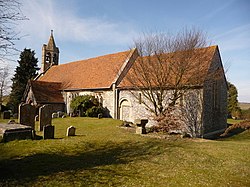Ipsden
| Ipsden | |
| Oxfordshire | |
|---|---|
 Parish church of St Mary the Virgin | |
| Location | |
| Grid reference: | SU6385 |
| Location: | 51°33’58"N, 1°4’59"W |
| Data | |
| Population: | 325 (2011[1]) |
| Post town: | Wallingford |
| Postcode: | OX10 |
| Dialling code: | 01491 |
| Local Government | |
| Council: | South Oxfordshire |
| Parliamentary constituency: |
Henley |
| Website: | Ipsden Village |
Ipsden is a village and parish in the Chiltern Hills in Oxfordshire, about three miles south-east of Wallingford in Berkshire. It is almost equidistant from Oxford and Reading, Berkshire.
Contents
Parish church
The Church of England parish church of Saint Mary the Virgin was built late in the 12th century as a chapelry of North Stoke.[2] It is said to have been the replacement for an earlier church that fell into disrepair in that century.[3]
The north aisle of the present church was built in the 12th century[2] and retains a Norman window.[4] The chancel arch is 13th century and the present south doorway is 14th century.[4] There had been a south aisle but this has been lost and its arcade blocked up.[4] Perpendicular Gothic windows occupy the south wall of the nave where the arcade had been.[4] The chancel east window is also Perpendicular Gothic.[4] The south porch was added in 1634 and the belfry in the 19th century.[4]
St Mary the Virgin parish is now a member of The Langtree Team Ministry: a Church of England benefice that includes also the parishes of Checkendon, North Stoke, Stoke Row, Whitchurch-on-Thames and Woodcote.[5]
The date of the vicarage has been disputed: the former Department of the Environment (DoE) dated it to 1643 but the architectural historians Jennifer Sherwood and Sir Nikolaus Pevsner considered about 1700 to be more likely.[4] It is of five bays and built of red brick with a pattern of blue bricks.[4]
Ipsden House
Ipsden House was built in the 17th century.[4] It was remodelled in the 18th century, probably 1764 which is the date on the rainwater heads, and one wing was gothicised in 1800.[4] In the grounds is a dovecote that the DoE dated to the 15th century but Sherwood and Pevsner consider to be 17th century.[4]
Early in the 19th century Ipsden House was the home of John and Anne-Marie Reade. Their son Charles Reade, born at Ipsden in 1814, became a novelist and dramatist. In 1823 their second daughter, Julia Susanna, was married to the missionary Allen Francis Gardiner (1794–1851). Another son, John Thurlow Reade, died in India in 1827, and there is a pyramidal stone monument to him in a field ½ mile north of Ipsden House.[6] Another member of the family, the historian and explorer William Winwood Reade (1838–75), is buried in St Mary's churchyard.
Between 1930 and 1939, Ipsden House was the home of novelist Rosamond Lehmann and her husband Wogan Philipps, 2nd Baron Milford.
Close to the house is a small stone circle, druidical in style.[6] It is not ancient but was created in 1827.[6]
Braziers Park
Braziers Park was built late in the 17th century: a date-stone in the cellar says 1688.[4] It was gothicised and ornamentally castellated in about 1799 by the builder and architect Daniel Harris.[4] It is now a Grade-II* listed building.[7] Since 1950 it has been the premises of an educational trust, the Braziers Park School of Integrative Social Research.[8] Since 2008 Braziers park has hosted the annual Wood festival.[9]
Other historic features
Ipsden Farm, just west of the village, has an 18th-century barn built of brick on an L-shaped plan with roofs that are tiled[6] and hipped. The barn is unusually large, being built of 24 bays and having five entrance porches.[6] It is a Grade-II listed building.[10]
The Olympic rower Richard Boyle was born at Ipsden in 1888. Eric Roll, Baron Roll of Ipsden (1907–2005) lived at Ipsden.
Amenities
Ipsden has a post office and village store.[11] Ipsden has a former village school in a part of the village called Newtown. It is now a pre-school for children 3–5 years old.[12] Ipsden has a village hall,[13] an amateur dramatic company[14] and a cricket club.[15]
The parish includes the hamlet of Hailey, immediately north of Ipsden village. Hailey has a public house, the King William IV.[16]
The parish includes Well Place, which used to have a zoo but has now closed down.
References
- ↑ "Area: Idsden CP (Parish): Parish Headcounts". Neighbourhood Statistics. Office for National Statistics. http://neighbourhood.statistics.gov.uk/dissemination/LeadTableView.do?a=7&b=798660&c=Ipsden&d=16&e=15&g=480810&i=1001x1003x1004&o=1&m=0&r=1&s=1268872974891&enc=1&dsFamilyId=779. Retrieved 17 March 2010.
- ↑ 2.0 2.1 Sherwood & Pevsner 1974, p. 662.
- ↑ The Langtree Team Ministry: History of St Mary the Virgin, Ipsden
- ↑ 4.00 4.01 4.02 4.03 4.04 4.05 4.06 4.07 4.08 4.09 4.10 4.11 4.12 Sherwood & Pevsner 1974, p. 663.
- ↑ The Langtree Team Ministry
- ↑ 6.0 6.1 6.2 6.3 6.4 Sherwood & Pevsner 1974, p. 664.
- ↑ Ipsden Village: Braziers Park
- ↑ Braziers Park School of Integrative Social Research
- ↑ Truck Festival: About WOOD...
- ↑ Geograph: SU6285: Ipsden Farm Barn
- ↑ Ipsden Village: Ipsden Post Office and Shop
- ↑ Ipsden Village: Schools in Ipsden
- ↑ Ipsden Village: Village Hall
- ↑ Ipsden Village: St Mary's Players
- ↑ Ipsden Cricket Club
- ↑ Ipsden Village: The King William Pub
Sources
| ("Wikimedia Commons" has material about Ipsden) |
- Sherwood, Jennifer; Pevsner, Nikolaus (1974). Oxfordshire. The Buildings of England. Harmondsworth: Penguin Books. pp. 662–664. ISBN 0-14-071045-0.